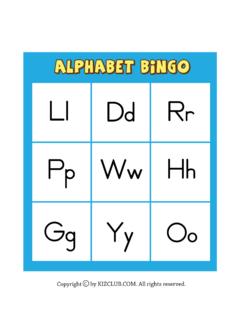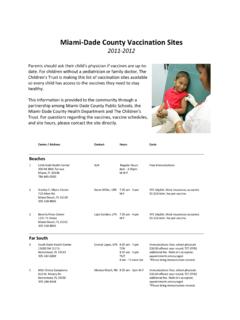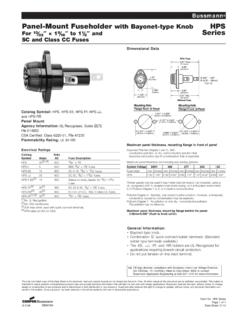Transcription of Sydney Burial Ground – Re-interment Register 1900
1 BDA Source Description Pages Sydney Burial Ground Re-interment Register 1900. The Title page from the following book reads: Sydney Burial Ground 1819-1901 (Elizabeth and Devonshire Streets) and History of Sydney 's Early Cemeteries from 1788 by Keith A. Johnson and Malcolm R. Sainty. published by the Library of Australian History, Sydney 2001. The book details a comprehensive history of the cemetery. One of the main sections of the book deals with the Re-interment Register that was compiled by the Department of Public Works of the NSW government in 1901, to record the names of the deceased who were being removed to make way for Sydney 's Central Railway Station. The history of this process, taken from the book, is reproduced below. The book also contains copies of documents relating to this process. It is copyright. ---------------------------------------- ---------------------------------------- ----------------------------- Removal of Sydney Burial Ground in 1901.
2 Government Gazette 22 January 1901, P. 433. Department of Public Works Sydney . 17 January 1901. City Railway Extension and Devonshire Street Cemetery It having been determined to extend the City Railway to Devonshire Street, notice is hereby given that in all cases where application has been made to the Minister of Justice by the representative of deceased persons buried in the Devonshire Street Cemetery and permission obtained to exhume such bodies with the sanction of the cemetery trustees within 2 months from this date the Department of Public Works will bear all reasonable expenses incurred in the Re-interment of such bodies in such cemetery as the said representatives may desire. The cost of removing and re-erecting all monuments stonework etc. now in a fair state of preservation will also be borne by the Government.
3 In the case of those bodies for which no applications will have been received at the expiration of this notice, exhumation will be carried out by the Government and re- interment will be effected at Rookwood Cemetery. page 1 BDA Source Description Pages Forms of application and other information may be obtained on application to the Clerk in charge of Bonds and Contracts at this Department. (Signed) Robert Hickson Under Secretary for Public Works and Commissioner for Main Roads. In 1901 the New South Wales Government invited descendants and relatives of those interred at the Sydney Burial Ground to relocate the monuments and remains. The Cemetery had been closed for more than twelve years and presented a deserted and neglected appearance. The total area of the Cemetery was resumed to make way for Sydney 's Central Railway Station.
4 In addition the following properties were resumed: The Police Barracks and Superintendent's residence, the Sydney South Morgue, the Benevolent Asylum (built 1820) which faced George Street at the corner of Devonshire Street, Christ Church Parsonage (built 1852) in Pitt Street, opposite Church, the Sydney Female Refuge, the Convent of the Good Samaritan and the Tram Depot. The last three formed part of the site occupied by the Carters Barracks prior to 1848. See the end papers of this volume for a "Plan of Part of the South End and Suburbs of the City of Sydney - P. L. Bemi, Surveyor, 1842. About one-third of the monuments were relocated in metropolitan cemeteries set aside during the second half of the nineteenth century, including Rookwood (1868), South Head (1869), Gore Hill (1868) and Waverley (1877). Others were transferred to country cemeteries, Goulburn, Cootamundra and Kincumber.
5 A. list of cemeteries where remains were re-interred is at the end of Appendix 2. A total of 1,568 applications were received by the Devonshire Street Cemetery Board of the Department of Public Works, claiming 8,460 known remains. Of approximately 4500 monuments surviving in 1901, about 2800 were relocated on 25 acres of government land adjoining Bunnerong Road, La Perouse and the existing Botany Cemetery which had been set aside in 1888. Very few went to Camperdown Cemetery, Sydney 's principal Church of England cemetery from 1849. until January 1868. The introduction of Licenses authorizing burials in cemeteries within the City of Sydney (namely the Sydney Burial Grounds) restricted interments in the Episcopalian portion to vaults only. The Sydney Burial Grounds Act of 1866. (30 Victoria 3) was enacted prior to the opening of the Necropolis at Haslem's Creek (Rookwood) in 1868.
6 Another Act restricted burials at the Camperdown Cemetery and at Cemetery, Randwick) from January 1868. Licenses to Bury in these three cemeteries were required. The Camperdown C. of E. Cemetery Company kept registers which record details of 17,962 interments. Almost 17,000 forms were also completed by undertakers and delivered to the Secretary of the C. of E. Cemetery Company. The latter forms often give additional information about the deceased. Surveyors' Books Before removal, a number was painted on each monument from which numerical lists were compiled in four note books by surveyors from the Department of Public page 2 BDA Source Description Pages Works during January and February, 1901. In total, 1,229 monuments were listed from the Church of England portion by David Dietrichson; 1,451 from the Catholic portion in two books by H.
7 P. Thomas, the first of which is lost and the second commences with grave number 1414. The remaining portions were listed in a fourth note book: 1,006 Presbyterian; 318 Congregational; 256 Wesleyan Methodist; and 268 Jewish. The only particulars recorded from the monuments in plot number order were name and date of death (presumably taken from the headstone), if decipherable. These books were placed by the Compilers for safe keeping, in the primary records of the Society of Australian Genealogists in 1972. Graves marked "B" - there are a number of graves in the Re-interment Register marked as plot B. These are probably monuments discovered face down or buried and were not marked by the surveyors in their initial numbering sequence. These occur in all denominations. A typed list of these exists for the Catholic section only and this is now housed in the Primary Records of the Society.
8 It contained several dates of death not recorded in the original Re-interment Register . These dates have been noted in the following edited Register as "Date from B list". Claimants There are extant 100 odd completed application forms addressed to the Trustees of the Church of England cemetery, to remove remains. These are dated January to May 1901 and are held in the Anglican Church Diocese of Sydney Archives and have been compared with the data in the Re-interment Register compiled in 1901. Extra data has been added to the edited Register , within square brackets, as well as being the subject matter of Notes I to 9, at the end of the C. of E. section of Appendix 2. There appears to be only one single (damaged) original Claimant's application form surviving. It is located at the Society of Australian Genealogists and has the format of a pre-printed Statutory Declaration subtitled Devonshire-street Cemetery.
9 This sample reads: I, Sarah Annette Buckingham of 201 Norton St. Leichhart in the State of New South Wales, in the Commonwealth of Australia (Occupation - not completed in this case). do hereby solemnly declare and affirm that 1. I am the only proper person entitled to apply for the exhumation and removal of the remains of my deceased relative(s) who (was/were) buried in the Roman Catholic portion of the Devonshire-street Cemetery. Letter 311 of Volume 2 dated 1 April 1901 states only "The following vouchers are sent herewith" it lists 14 names of which "J. Larkin " It is assumed that Mr Larkin spent only this amount and not a previous estimate. page 3 BDA Source Description Pages Letter 550 of Volume I appears to be in reply to a request to re-inter without first obtaining an estimate. It names "Barbara Burns, George Burns and Christina Moffitt buried in the Church of England portion in about 1852, 1849 and 1856 respectively to remove to the Church of England, Rookwood.
10 At all reasonable expenses incurred". Letter 177 in volume 2. 26 March 1901 to Mrs Elizabeth Larkin, 42 Sydney St., Erskineville "remains of John and Mary C. McGibbon, Elizabeth, Henry and Mary C. to Rookwood ". The above Mrs. Elizabeth Larkin (nee White) (1847-1930), a great-great- grandmother of Keith Johnson, one of the Compilers of this volume, made application to the Devonshire Street Cemetery Board in March 1901 to remove, from the Presbyterian portion, the remains of her maternal grandparents, John McGibbon (d. 1842) and Mary McGibbon (d. 1858), her mother Elizabeth White (d. 1860) and her brother and sister Henry and Mary White who died in infancy (mid 1840s). As there was no monument Mrs. Larkin presumably had pointed out to her, probably by her mother before her death, when Elizabeth was 12 years of age, the Burial place of her grandparents and brother and sister.








